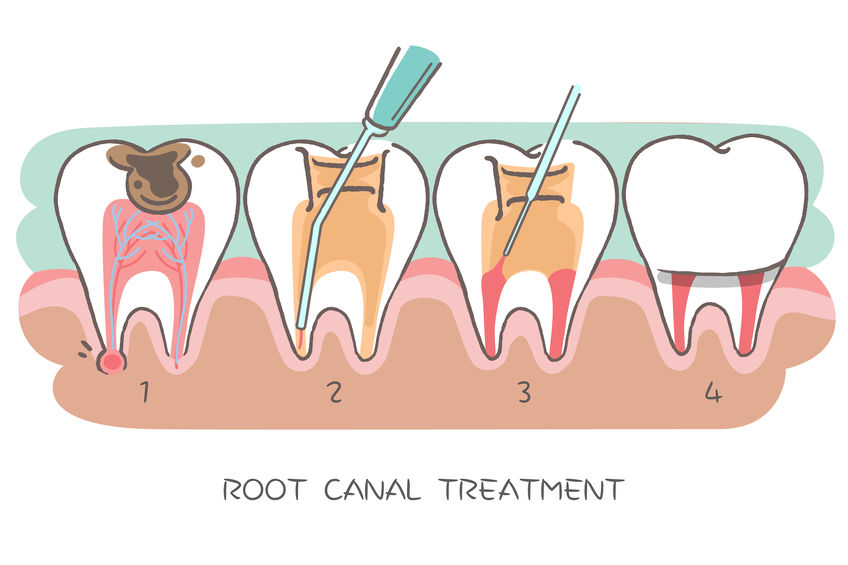The open space inside the root where the pulp extends from the pulp chamber is called the Root Canal; it is also called the Pulp Canal. It houses blood vessels and nerves from surrounding outside enter the pulp through the root.
When the pain is in the root either because of inflammation or infection, the procedure performed is called Root Canal Treatment (RCT). RCT not only relieves plain but also saves the tooth. The dentist who specializes in this procedure is the Endodontist. What the Endodontist does is to carefully remove the pulp from within the tooth, disinfect the root canal, and fills the empty canal with a filling.
Indications for RCT:
There could be many reasons why a RCT is required, but the primary reason is inflammation or infection of the tooth. Some situations when RCT is considered:
- When there is a carious lesion that has crossed the enamel, dentine and has reached the crown.
- Repeated dental procedures on the tooth.
- When a crown has been placed faultily
- When there is a crack or chip in the tooth.
Untreated pulp infection or inflammation can lead to abscess. Most Endodontist, try to save the natural teeth as it helps to maintain the normal physiology of the oral tissue, it maintains the natural smile and allows the person to eat normal. It also reduces the need for greater dental rehabilitation. Teeth that have had the root canal treated can last a lifetime if properly cared for.
Symptoms that suggest that you might need a Root Canal Treatment
- Severe pain while chewing or biting.
- Eruptions on the gums. (These tend to look like pimples)
- A tooth that can be chipped or cracked
- Sensitivity to heat or cold which continues. Particularly the reaction to hot food items.
- Swollen gums. They may also feel tender.
- Darkening of gums due to deep decay.
The Root Canal Treatment (also known as endodontic treatment) is usually performed in two or three visits procedure is follows:
- A radiograph is taken to examine the tooth, bone structure and the exact extent of the lesion.
- If the infection is active then antibiotics are prescribed.
- When the Endodontist, begins the procedure local anaesthesia is administered and dental dam is used to isolate the tooth, this is a small protective sheet, which keeps the working area clean and free of saliva.
- The Endodontist then accesses the pulp chamber by making an opening in the crown of the tooth. Very small instrument called the reamers are used to clean the infected tissue. And the canal is widened such that there is only healthy tissue within. This space is now hollow.
- This hollow is cleaned, shaped and irrigated. After which a rubber like material is used fill the hollow canal. This material is biocompatible. The gutta-percha is then placed with adhesive cement. It is absolutely essential to make sure that the root canal is completely sealed. The Endodontist then places a temporary filling.
- Once the Endodontist has completed the procedure, then the dentist places the permanent restoration or a crown to protect the tooth and restore it to functionality.
After the RCT and excavating the pulp if the tooth lacks sufficient material to bear the load, then a post may be placed in the root canal to support the tooth. An RCT is painless and leaves less discomfort than an extraction. However, there are lot of myths around RCT, particularly with regard to pain, inconvenience, repeated dental visits and cost. In the long run however an RCT works better as it protects the natural teeth.
Some myths about Root Canal Treatment.
Pain
Earlier anaesthesia was not administered for an RCT. With use of anaesthesia, so the discomfort and pain felt is just as much as one feels during a restoration. The reality is once the infected tissue is eliminated by the Endodontist the pain reduces. Advanced technology reduces the chair time considerably.
Root canal treatment causes other illness
Very often there is a misconception that once you have had a RCT you are more susceptible to future infection. This claim has been disproved nearly a century ago, for it was based on research designed before modern medicine understood the causes of diseases as we understand it today.
Extraction is better than RCT
This was a belief that came from the information that the tooth becomes non-vital after RCT. But saving your natural teeth is always the best option. Even after RCT the tooth remains functionally and aesthetically efficient.
Caring for your teeth after RCT
Immediate: you will not require staying in bed, but an NSAID like ibuprofen is often prescribed to manage the inflammation and any swelling that might occur. Since anaesthesia is used the mouth will numb for a few hours after the procedure, during this period food that requires chewing or food that is hot should not be eaten.
Next few days: take the medications as prescribed. Food eaten should be soft and should require minimum chewing. Avoid eating on the side where the procedure was performed. Brush with care. The pain usually subsides in a day or two. In more severe cases a second sitting might be required to eliminate the infected tissue completely.
Long term care: do not neglect follow up appointments, and the replacement of temporary restoration with the permanent restoration or crown.
Complications are very rare with RCT; however as with any procedure there could infections, remnants of the pulp, or tooth cracking particularly if proper follow up and aftercare procedures are not completed. If the pain or swelling does not subside in the first couple of days you should contact your dentist.
It is quite likely that the RCT is less stressful during and after the procedure, as compared to situation leading up to it. Currently technology and procedure has made the process rather painless, and mild discomfort could be present for a few days.


